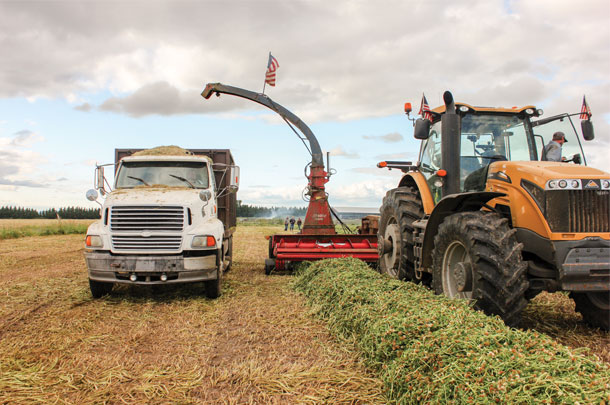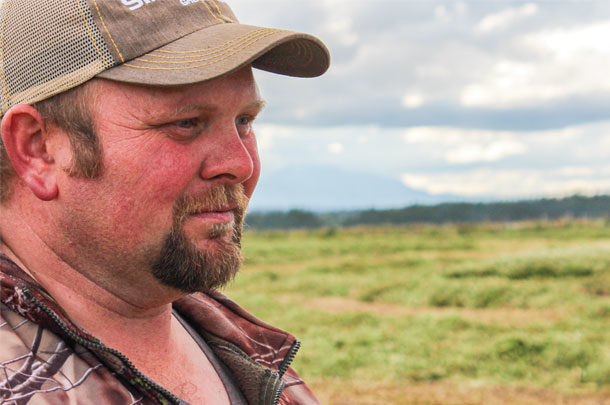Located in the central region of the Willamette Valley near Halsey, Oregon, the success to Willaval Dairy Farm walking the margin tightrope has been an investment into the farm’s forage production, says Chris Freitag. Milking 350 head of Jersey cross Friesian cows on a quality contract, 80% of its ration is grown on 280 acres of silage ground.
“Our ration is supplemented with bought-in grain, and depending on the year, a little bit of alfalfa,” says Freitag. “Other than that, it is comprised of high-quality, homegrown forage. We have found this method to be the most cost-effective way to feed our cows – which, as any livestock producer knows, is the biggest input cost to a dairy business.”
With an annual target of 50 tons of silage per acre, Willaval Dairy Farm relays its ground between a spring and fall silage crop. Drilled in the third to fourth week of May, corn is chopped for silage toward the end of September. “Prior to corn going in the ground, we conduct soil analysis and rectify any deficiencies and to get our pH right and also spread dry manure from our cows to improve fertility,” Freitag says.
Once the corn is chopped, the ground will then be drilled to a winter forage crop to be cut for silage the following spring, with a harvest target in the first two weeks of May. In years when post-corn-silage-harvest conditions are too wet, the land is direct drilled with Italian ryegrass. However, when conditions are drier and allow for more groundwork, silage fields are disked and leveled and then planted with balansa clover. With the ability to survive in temperatures as low as -14ºF and through short periods of standing water, this cold-tolerant variety has been an ideal legume option for the farm to increase its forage quality and quantity.
“Because we’re in a high-rainfall area and receive showers very regularly in the fall, getting ground worked for a good clover seedbed can be a challenge, since it needs 45 days of growth before the first hard freeze. However, anytime conditions will allow, we will always grow FIXatioN balansa instead of annual ryegrass, due to its quality and quantity advantages,” says Freitag. On average, his balansa clover will give the farm 25-30 tons of silage per acre at 25% protein, if harvested before going to bloom. If wet conditions delay harvesting until the clover has bloomed, protein will typically sit around 15%.
“In a good year, our annual Italian ryegrass will yield 20 tons of dry matter per acre and has even been known to hit 20 percent protein. However, if weather delays silaging and grass goes to head, protein will quickly drop to 8 percent,” Freitag says. “Overall, it’s much more economical for us to grow clover when we can. Not only is the quality loss much more forgiving if harvest has been delayed, but its consistency in high protein allows us to cut bought-in alfalfa out of our ration completely.”

Growing ‘super silage’
According to Jerry Hall, director of research for GO Seed, using a legume in a corn silage rotation has more benefits than just giving forage production a boost. “One of the great things about incorporating a legume like balansa clover is avoiding a grass-on-grass rotation. This is going to offer a more diverse root system to break up compaction issues that are typically caused by harvesting silage in wet conditions,” Hall says. “The more fibrous root is also going to help improve the cycle of nutrients through the soil.”
Before growing an annual clover monoculture for silage, Hall says producers need to look at their chemical program for the previous crop to ensure residuals won’t destroy the subsequent legume crop. They also need to look at their growing and harvesting windows to have at least 45 growing days before the first frost.
When it comes to establishment, Hall recommends working the ground to get a smooth, firm seedbed to drill 0.25 inch or less at a seeding rate of 8 pounds per acre. “Growth will be limited in the growing period before the clover goes dormant after frost; however, once spring arrives, it will take off. Weed control typically isn’t an issue because the rapid pace of high-volume growth swallows anything with it,” Hall says.
Future-proofing the business
While there has been a learning curve over the years for Willaval Dairy Farm to integrate clover silage into their system (see sidebar below), it has resulted in huge benefits for the Freitag family’s overall system.
“Being able to push our homegrown forage production even further to maintain herd performance while slashing inputs has been instrumental to us maintaining a profit margin in an industry with such volatile markets,” Freitag says. “This has been essential in future-proofing the business for not only the current generation but also the next.” ![]()
PHOTO 1: Chris Freitag is the fourth-generation producer at Willaval Dairy Farm in Halsey, Oregon. Milking 350 Jersey cross Friesian cows, maximizing homegrown forage production is essential to the farm’s profit margin.
PHOTO 2: Due to the high tonnage of balansa clover crop, Willaval Dairy Farm found it was better to run it through a chopper instead of a forage harvester. Photos courtesy of GO Seed.
Laura Wise is a freelance writer.
Tips for harvesting clover silage
1. Be patient
Early growth will be limited but will pick up in the spring.
2. Mow in a row instead of raking.
Measuring 9 feet long, the clover plant will wrap around winding rakes. If possible, avoid raking completely.
3. Don’t overwilt it.
Let it wilt for a couple of days to get rid of some of the moisture, but don’t overdo it. Letting it get too dry makes it hard to pack down.
4. Make sure your equipment is up for the task.
The high biomass may be too much for a forage harvester. If in doubt, you can always chop it.
5. Cut before it blooms.
If quality is your top priority, cut it before it blooms to get the highest protein. However, if you are after quantity, pushing harvest dates back by even 15 days can increase yields by thousands of pounds.






